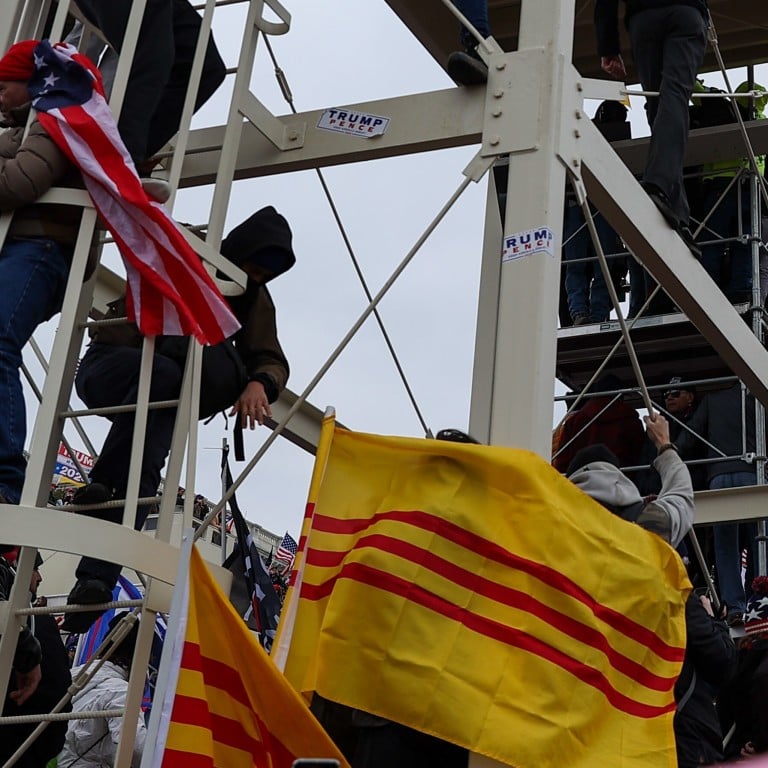
Why the flag of South Vietnam flew at US Capitol siege
- Amid the chaos on January 6, yellow-and-red striped flags of the former South Vietnam stood out
- The protesters flying those flags were likely Vietnamese-American supporters of Trump, who favour his anti-communist and anti-China stance
Alongside US flags, anti-Semitic banners and Confederate battle flags flew the yellow-and-red striped flag of the former South Vietnam.
This confounded many onlookers. One Reddit user wondered why the mostly white “anarchist mob” had “co-opted” South Vietnamese iconography.
Why are so many Vietnamese in the US pro-Trump and anti-China?
Election surveys find that Vietnamese-Americans were the only Asian-American group in which a majority voted for Trump last year. They are attracted to Trump’s hard-line stance against China, anti-communist rhetoric and self-avowed commitment to protecting America against all enemies, foreign and domestic, according to journalists and researchers.
The South Vietnamese flag recalls Vietnam’s own “failed” democracy – and the people’s struggle to save their nation.

A NATIONALIST FLAG
After Vietnam gained independence from French colonial rule in 1954, the country split into two, sparking a civil war. The United States helped establish and back South Vietnam, a pro-Western democratic republic that fought communist North Vietnam. American ground troops formally joined the war to defend the south in 1965.
In 1975, opposition forces overtook the South Vietnamese capital, then named Saigon. Crashing through the gates of the main palace, they seized the building and raised the flag of the revolutionary northern government.
The “fall of Saigon” was the turning point of the war, which caused over 1 million North Vietnamese deaths, military and civilian, and a quarter-million South Vietnamese casualties. The war killed nearly 50,000 American troops and displaced about half a million people.
How Asia saw the chaos of Trump fans storming US Capitol
Many Vietnamese refugees sought asylum in the US. Today, they invoke the ongoing cultural value of this “fallen” regime by flying the South Vietnam flag at Lunar New Year parades and musical concerts.
The flag reflects community solidarity, but it also has a more fraught symbolic meaning.
As I wrote in my 2018 book, Returns of War: South Vietnam and the Price of Refugee Memory, some Vietnamese-Americans view their fallen homeland as an extension of the American push for freedom and democracy worldwide.
I have interviewed Vietnamese-American soldiers who fear American freedom is failing and fervently believe in the US’ activity in places like Iraq and Afghanistan.
For them, flying the South Vietnam flag is a show of nationalism – a militarised patriotism that is simultaneously South Vietnamese and American.

03:15
World shocked by assault on the US Capitol by radical pro-Trump supporters in Washington
CHANGING POLITICAL LOYALTIES
I have also observed how Trump employs old anti-communist tactics that appeal to some conservatives in this community.
Last year, he tweeted for his followers to “liberate” the country by force from Covid-19 lockdowns. Hours before the Capitol insurrection, he urged supporters to “fight like hell” to defend his administration.
A handful of Vietnamese-Americans heeded that call, participating in local “stop the steal” rallies in California. Participants at the Capitol’s armed takeover have only begun to be identified, but media outlets captured what appear to be Vietnamese-Americans holding up the South Vietnamese flag.
Why are Vietnamese big fans of Trump – both in the US and in Vietnam?
These protesters likely believed the US needed to be saved from socialists – which is what Republicans falsely paint Biden to be – as their white counterparts claimed to believe. Different from their white counterparts, they were inspired to subvert democracy by the memory and politics of the fall of Saigon.
Vietnamese fealty to the Republican Party may be waning. Social scientists find younger Vietnamese Americans lean more progressive. Born after 1975, they never fought communism nor fled it as refugees. Like their parents though, these Vietnamese-Americans live in a country at war with itself.
Long T Bui is Associate Professor of Global and International Studies, University of California, Irvine. This article was first published on The Conversation.

